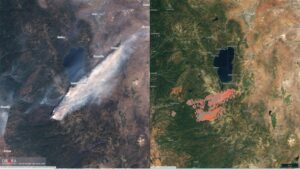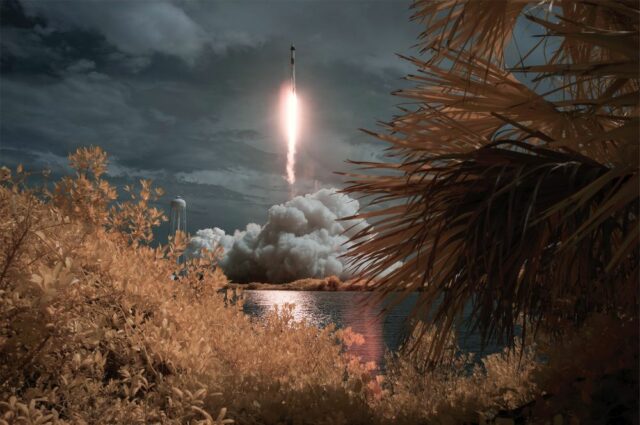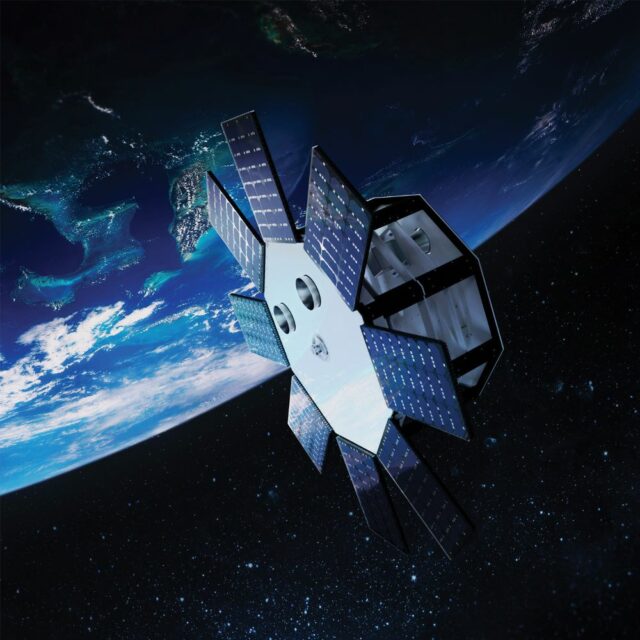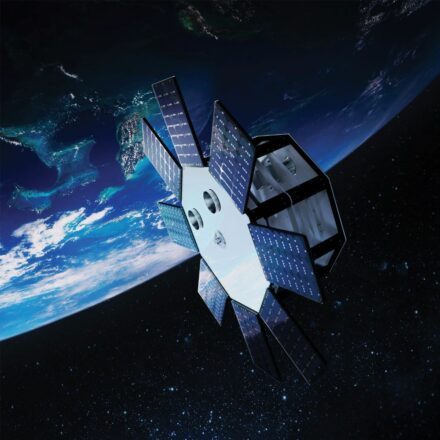The yacht drifted helplessly in the stormy North Atlantic, seven miles west of Ireland. Ocean swells towered over the disabled craft. With its mast and communications system gone, the veteran sailor aboard had one hope: his two emergency position-indicating radio beacons (EPIRBs).

Meanwhile, in rough seas, a merchant vessel tried and failed four times to rescue the sailor. Finally, 36 hours later, another ship was able to save him.
EPIRBs send signals to COSPAS-SARSAT, an international satellite system for search and rescue. Satellites that pick up distress signals transmit them to ground stations that then forward them to rescue agencies. NASA says the system has helped rescue more than 50,000 people worldwide since 1982—including 275 rescues at sea in 2022 alone.
The 62 COSPAS-SARSAT satellites are one small element in the rapidly filling realm above the atmosphere.
Satellites enable precision agriculture, monitor the environment, track pollution, monitor illegal activity in protected areas—and, of course, power the GPS that lets us find the nearest coffee shop or make our way in a strange city. All the while, satellites have gotten cheaper, smaller and smarter. The tiniest devices, picosatellites, weigh under two pounds. Nanosatellites, or nanosats, weigh in at less than 22 pounds, with microsatellites reaching around 220 pounds.
These miniature orbiters enable a new business model: space as a service. Instead of spending millions of dollars and years designing and building their own satellites, anyone with a small budget and an idea can rent computing cycles or space on this new generation of spacefaring hardware.
Like SaaS for space
Space as a service follows the well-established software-as-a-service model, with similar benefits. In the early days of the internet, if you wanted to run complicated applications, you had to buy racks and racks of computers and expensive software. You also had to hire a staff to set up the software, keep it running and install upgrade after upgrade.
As computers became more affordable and more powerful, software vendors could build their own server farms to run their software and let customers log in to use it. Cloud software, offered as a service with a subscription, was cheaper and more accessible—and novel businesses arose.
It’s the same with satellites. Early satellites were as big as a washing machine or even a school bus. The high cost and risk of building and launching a satellite were prohibitive.
Today, the newest generation of nanosats are no bigger than a loaf of bread. But they’ve got processing power to spare. Space as a service lets satellite providers rent that power to a diversifying range of customers, including shipping and logistics, aviation and broadband companies.
“In the early days, the loaf-of-bread satellites were the PCs to the traditional satellite mainframe. That was the first wave,” says Joel Spark, co-founder and chief satellite architect of Spire Global. “Space as a service is the second wave. If you want to deploy an application to space, rather than your first step being buying a satellite, you can rent existing assets or build on top of existing infrastructure that we provide.”
Spire provides space-based data, analytics and, increasingly, space services to hundreds of companies. Services may include incorporating a customer’s device, running its software or providing data from Spire’s own devices.
Earth intelligence
New tech startups are innovating, thanks to space as a service. One of the most valuable results of the satellite boom is what Spark calls Earth intelligence: “Finding new and unique ways to understand what’s happening now and how our planet is evolving. It can help companies understand, mitigate and, in some cases, even reduce climate change.”
For example, OroraTech placed an artificial intelligence (AI)-enabled thermal-infrared camera on a Spire satellite to develop a wildfire early warning system. Its system can give an alert within 15 to 30 minutes of a wildfire’s igniting.

“We’ve seen the potential to save forests, help firefighters on the ground and reduce CO2 by reducing emissions from fires burning. The forest acts as a carbon sink, too, so that has double value,” says OroraTech CTO Martin Langer.
Spotting fires as they erupt is just part of the value, according to Langer. Observing a fire as it burns leads to the creation of better models of how smoke travels. Monitoring ground temperatures improves weather forecasting, benefits agriculture and lets forecasters correlate temperatures with other factors.
If you want to deploy an application to space, rather than your first step being buying a satellite, you can rent existing assets or build on top of existing infrastructure that we provide.
—Joel Spark, co-founder and chief satellite architect, Spire Global
OroraTech has a hybrid approach to its services. In addition to space as a service, it’s built its own satellites and makes use of data from other operators such as NASA and the E.U.’s Copernicus.
The advantages of space as a service are risk mitigation and speed, Langer says. Large satellite missions only launch every 15 to 20 years. Everything you want to launch has to be on board—and it has to work.
“For an engineer like me, that means you can only launch two or three missions in your career,” Langer says. “For startups like us, if you can’t deploy your service fast enough, it’s going to fail. We had to launch our first satellite within a year. Space as a service gives you lots of flexibility and speed. And with that comes innovation.”
Space Force signs on
Space as a service has one potentially huge customer: the U.S. military. While government agencies have typically distrusted solutions not developed internally, the Space Force is taking a new approach. It wants to get its hands on the best technology, no matter who builds it.
At the beginning of 2022, the Space Systems Command established the Commercial Services Office, or COMSO, to contract with commercial companies. Space as a service is an important part of the strategy.
“The full official strategy is: Exploit what we have, buy what we can, build only what we must,” says Jeremy Leader, COMSO director.
Leader sees three benefits to the space-as-a-service model. First, there’s the potential for cost savings, because a company’s costs are spread among many customers instead of one. Second, it moves the onus for innovation and modernization onto the companies providing the services. Finally, commercial companies tend to use familiar interfaces and controllers instead of exotic terminals, which shortens training and speeds implementation.
And then there’s the challenge of requirements versus innovation. In the military’s classic model, equipment is custom-built to order. Leader says, “We have an antiquated requirements process and, when everything is built to requirements, there’s the assumption that the person writing the requirements knows what’s out there. We will need to have our finger on the pulse of what commercial space can do.”
As Leader explains, if the Department of Defense had to choose between maintaining existing equipment and taking a risk by modernizing, the choice previously was always to stay with the tried-and-true. However, with space as a service, “The risk is on the companies. We don’t want to be, nor have we been, the driver of a lot of innovation in the recent past.”
Space as a service gives you lots of flexibility and speed. And with that comes innovation.
—Martin Langer, CTO, OroraTech
Space-as-a-service companies can move much faster and take advantage of not only increases in computing power but also emerging technologies like 5G to send more data faster, 3D printing to quickly make custom components and AI to analyze data before it’s sent to Earth.
Sidus Space uses commercial off-the-shelf components and 3D printing of some parts to make its LizzieSat lighter and more modular.
Weighing around 200 pounds, a LizzieSat can take up to 44 pounds of third-party equipment, like sensors, imaging or IoT (Internet of Things) devices. With a production cycle of around 12 months, Sidus founder and CEO Carol Craig says, “Our tagline, Bringing space down to Earth, isn’t just a catchphrase. Our goal is to make space accessible and open to everyone. Just like the internet is ubiquitous, we want to see the same ubiquity in a few years with satellites, satellite data and access to space.”
A crowded space
Earth’s airspace is getting busier. Some 5,465 operable satellites orbit the globe, 3,000 of which are operated by U.S. companies. And there’s a downside to the proliferation of these little orbiters: space junk. The International Space Station has been threatened by debris several times. In November 2021, astronauts were ordered to suit up and huddle inside the space station when wreckage from a 26-year-old satellite blasted by.

Meanwhile, more and more satellites crowd the skies. In January 2023, SpaceX sent 114 satellites into orbit with a single launch.
Space has been something of a free-for-all, with little regulation or oversight on what gets put into orbit and how long it stays there. In the U.S., the Federal Communications Commission regulates satellites. Until late 2022, it had only issued a guideline that an orbit must decay within 25 years, at which point the satellite would fall to Earth—wherever. Now, there’s a firm rule: Newly launched satellites must be decommissioned or fall to Earth in five years. But where they fall is still unregulated, and the rule doesn’t apply to the thousands of devices already hurtling around up there at speeds of 17,000 mph or more.
Satellites are already causing light pollution and interfering with readings from some orbiting sensors. When satellites crash back to Earth, they can release hazardous amounts of alumina into the atmosphere. And chunks falling in populated areas could crush houses or even kill someone. In January, NASA said the possibility of injury from the wreckage of its 5,400-pound ERBS satellite was “very low”—but not zero.
This is one of the advantages of nanosats: Because they’re so small, they will burn up in the atmosphere before reaching Earth. Also, smaller satellites equal less mass in space overall, so they’re less likely to collide, according to Spark.
Just like the internet is ubiquitous, we want to see the same ubiquity in a few years with satellites, satellite data and access to space.
—Carol Craig, founder and CEO, Sidus Space
In one scenario, space as a service could reduce the total number of satellites needed, because multiple entities could take advantage of a single nanosat. Some Spire customers have logged onto existing satellites already in space through simple software upgrades, eliminating the need to launch a new satellite.
On the other hand, as the value of space becomes more relevant to more organizations, the demand for satellites could outpace the capacities of existing space-as-a-service devices, resulting in more and more little satellites buzzing around the Earth like a swarm of bees.
They say no one knew they needed email until they got it. You can say the same about space. By sharing the capabilities of the satellites already in space, organizations can save money, enable greater innovation and protect our environment both on and above Earth.
Space may not be, as Captain Kirk said, the final frontier. But it’s the new frontier—and it’s open for business.
Lead photo: an artist’s rendering of the LizzieSat in orbit. The satellite is expected to launch in 2025.of Sidus Space. Courtesy of Sidus Space.
Want to read more stories like this? Check out Realize magazine.


